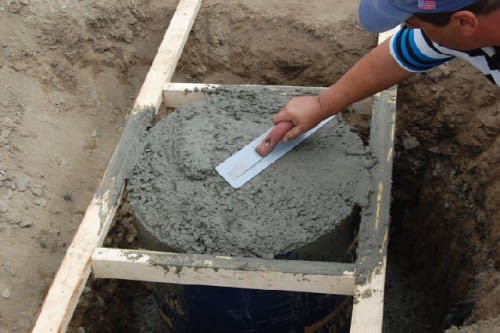Location is Miami, Florida and the water table is about 24" below existing grade.
I have a 6' tall wood fence with 4X4 posts spaced at 4' interval (hurricane code). I also have a 10' wide double gate (each gate 5' wide) and the posts are 6X6 pressure treated lumber.
Posts are excavated with a post hole digger down to 24", then the post inserted, concrete mix are poured into the holes till level or slightly above grade.
Over the years the wood posts would rot (from moisture, from termites) and need replacement. The regular fence posts one can dig a hole say 2' over and install all new posts shifted and the old posts cut off at grade. However the gate posts cannot shift.
The old gate posts was removed by excavating around the concrete anchor, thus making a wider and bigger hole, then the post and concrete extracted, new posts inserted into this much bigger hole and more concrete poured into this hole to make a bigger wider anchor.
After three replacements over the past 15-20 years the hole that was excavated for the gate post went from 8" diameter to 14" diameter to 20" diameter. It is getting too wide and too heavy to attempt another iteration. If I am able to pull out the current posts and huge concrete anchor, leaving a 20"+ wide crater, how can I install a new post at the same location?
If I backfill soil/sand into the large hole, and compact the soil as much as possible, then RE-excavate a 10" diameter hole from the backfilled hole, then insert the new post and pour concrete into the new hole, I assume the post anchors will not have the same strength as the backfilled soil will have a lesser bearing capacity than the original undisturbed soil. I wonder how much weaker it will be.
I know another thing I need to tackle is to stop the posts from rotting at the base. I planned to wrap a piece of ice&shield barrier around the post where it meets grade, and build up the concrete anchor into a pyramid to allow water to run off, so hopefully that will make the posts last longer.
I have a 6' tall wood fence with 4X4 posts spaced at 4' interval (hurricane code). I also have a 10' wide double gate (each gate 5' wide) and the posts are 6X6 pressure treated lumber.
Posts are excavated with a post hole digger down to 24", then the post inserted, concrete mix are poured into the holes till level or slightly above grade.
Over the years the wood posts would rot (from moisture, from termites) and need replacement. The regular fence posts one can dig a hole say 2' over and install all new posts shifted and the old posts cut off at grade. However the gate posts cannot shift.
The old gate posts was removed by excavating around the concrete anchor, thus making a wider and bigger hole, then the post and concrete extracted, new posts inserted into this much bigger hole and more concrete poured into this hole to make a bigger wider anchor.
After three replacements over the past 15-20 years the hole that was excavated for the gate post went from 8" diameter to 14" diameter to 20" diameter. It is getting too wide and too heavy to attempt another iteration. If I am able to pull out the current posts and huge concrete anchor, leaving a 20"+ wide crater, how can I install a new post at the same location?
If I backfill soil/sand into the large hole, and compact the soil as much as possible, then RE-excavate a 10" diameter hole from the backfilled hole, then insert the new post and pour concrete into the new hole, I assume the post anchors will not have the same strength as the backfilled soil will have a lesser bearing capacity than the original undisturbed soil. I wonder how much weaker it will be.
I know another thing I need to tackle is to stop the posts from rotting at the base. I planned to wrap a piece of ice&shield barrier around the post where it meets grade, and build up the concrete anchor into a pyramid to allow water to run off, so hopefully that will make the posts last longer.

